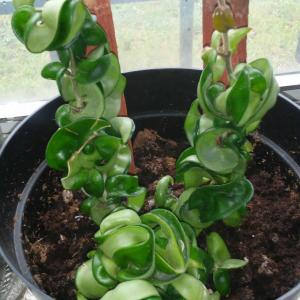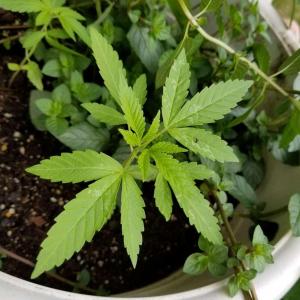求助
Penney
2017年07月06日

Is this hanging one a banana plant?


1
0
Penney:@sara iordenz993, see I'm not sure mine are long and skinny,not sure if it cause it came off a older really long plant or if it's totally different. thanx
sarajordan2993:i believe so , heres a stem of mine – not too sure though
求助
meriunkat
2017年07月05日

(First picture is mine) anyone know the name of this plant?


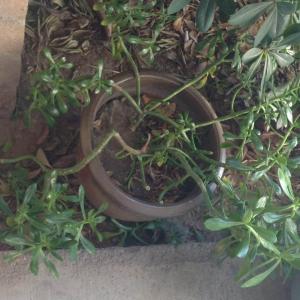



1
0
Penney:I have this also,all I know is that it's a member of the Jade family.
文章
linpei
2017年07月04日

A beautiful holiday plant (botanically known as Schlumbergera or Zygocactus), the Christmas Cactus unsurprisingly blooms at Christmas and also sometimes around Easter time if cared for properly. A month prior to Christmas you will be able to watch the tips of the leaves beginning to grow. The tips grow darker as each day passes, until a bud forms. At Christmas time, as if by magic, the buds open to a beautiful flower that will add color and warmth to any holiday season.
Choosing Your Spot, Soil, and Set-Up
1.Give your Christmas Cactus bright but indirect light. Keep the plant in a well-lit location (like near a window) away from direct sunlight – too much heat and light can stunt growth and burn the leaves. It should also be away from drafts, heat vents, fireplaces or other sources of hot air.[1]
Move an indoors plant outdoors in summer to a shady location. It is best to keep in a normal house temperature range, about 65 to 75°F (18 to 20°C). That being said, cooler night temperatures can be used to initiate blooming. We'll discuss getting it to bloom in the final section.
If it's in a north or east-facing window, you won't have to worry about light. But if it's in a south or west-facing window, diffuse the light with semi-transparent curtains or some other light-diffusing device.
2.Provide the plant a source of humidity if you live in a dry environment. Put a tray of water next to the plant so that the water evaporates and provides humidity. Alternatively, you can make a humidity tray by placing the pot on a waterproof saucer that is filled with gravel and halfway filled with water.
50 to 60% humidity is the ultimate goal.[2] If your environment is close to that, you should be fine.
3.Use a well-draining container and well-draining soil. For the container, some of the cheap nursery planters will work well, and orchid planters (the plastic basket kind) work well also. Pair this planter with a planter that will hold water and allow the basket to fit down into it. Then, place a few medium sized rocks into the bottom so that the basket container will be held about an inch above the bottom. [3]
Use a combination of 3 parts potting soil to one part sand for the potting medium. An alternative is one part potting soil, two parts peat moss or compost, and one part sharp sand or perlite.[4] Whichever way you go, pour about two inches of room temperature water into the outer container and set the basket container inside. After about twelve hours, pour out any remaining water. Repeat this as often as the plant needs water; it will vary based on your home's condition. Monitor its need with a moisture prod and adjust accordingly.
4.Add fertilizer to assist plant growth. Plants that are actively growing should be given a blooming houseplant-type fertilizer. This is best done for a plant that is 2-3 weeks old. Follow the label directions for how much and how often to feed.
Fertilizing is important to keep the plant in good condition; the joints are fragile and can break apart if the plant descends into poor health. Generally, it should be fertilized 2-4 times a year with a 20-20-20 feed, but stop feeding about a month before the buds appear (this usually means stopping by the end of October).

Watering Your Christmas Cactus
1.Water a Christmas Cactus with care. Caring for this plant can be a bit tricky as you need to take care not to overwater or underwater it:
A Christmas cactus is a tropical cactus, not a desert cactus. Unlike most desert cacti, this variety cannot tolerate completely dry soil. If the soil gets too dry, the flowers buds will drop, and the plant will wilt. Feel the soil with your fingers; if it feels dry, it's time to water.
Too much watering will cause spots from white rot to appear on the leaves, and the leaves will likely fall off. The soil should be evenly moist for best growth. The rule of thumb is less water is better than too much water.
When watering, thoroughly water the plant. Before attempting to water the plant again, check to see that the top inch of soil has dried thoroughly first. Mist leaves as well as watering the soil.
2.Change your watering schedule seasonally. Water the cactus based on your environment and the time of year. A good method is to water a cactus as follows:[5]
Dry climate, outdoors: Water every two to three days when warm and sunny
Humid, cool or indoors: Water every week
During the fall and winter months, the plants should be watered less frequently in order to promote blooming.
3.Stop watering around October. When October hits, your watering duties are over. You can carefully resume a light watering in November. If it's dry where you live, feel free to place the pot over a tray of moist pebbles. This is all to set up the bloom happening around Christmas.
The only other time you should cease watering is after the plant blooms. At this time, cease watering for about 6 weeks to allow the plant to rest. New growth will still appear – and that is when watering should be resumed.
4.Watch out for bud drop. One of the most frustrating things that can happen to Christmas cactus is after the flower buds have developed they drop off the plant. Bud drop can be caused by several different conditions. Usually it's because of over-watering, but it can also be due to a lack of humidity or insufficient light.
If this starts happening, water the plant less and add some fertilizer to the pot. Move it to an area away from a hot radiator or vent and try a new spot where it can get a bit more sunlight.

Getting a Timely Bloom
1.Encourage the flower blooming for the holiday season by lowering the temperature. The key to getting Christmas cactus to flower during the holiday season is proper light exposure, correct temperatures and limited watering. If you manipulate these things yourself, you can time a bloom just how you'd like.
Because this plant is thermo-photoperiodic, it will set buds when day length is about equal to night length and when the temperature drops to 50 to 60 degrees F for several weeks. If the temperature drops further, the plant will not bloom.
From September and October, the Christmas Cactus should be kept in a cool room where temperatures will remain around 50-55°F (10-12°C), give or take a few degrees. Don't expose the plant to freezing temperatures. Plants should be blooming for the holidays if cool treatments are started by early November.
2.Keep the plant in a dark room during the night. During the fall months, the Christmas Cactus should be placed in a spot where it receives indirect, bright light during the daylight hours but total darkness at night – it requires long, uninterrupted dark periods of about 12 hours or more.[6]
Begin the dark treatments in about mid-October to have plants in full bloom by the holidays. Place the plants in a dark area from about 12 or more hours each night for 6-8 weeks or until you see buds forming. A closet or unused bathroom are ideal places.
Be especially careful with watering at this time. Reduce the watering slightly. Do not soak the soil after a dry period; only moisten the top few inches, since buds, flowers and even leaves can fall off if the roots are suddenly saturated.
3.When you see flower buds forming, increase light and humidity. The "dark ages" are over when your plant starts budding. At this point, you should increase, humidity, light, water (not too much, of course), and the temperature. In other words, continue as you were a few months ago.
If the buds form too early, you can lower the temperature to stunt them. When you're ready, up the temperature and they should resume their progress.[7]

Caring for Your Cactus Post-Bloom
1.Prune the Christmas cactus about a month after blooming. This will encourage the plant to branch out, especially after a period of "rest" has been granted. It will not look very pretty after the blossoms have faded. Some people wait until March or so, when new growth begins, to prune the cactus.
As mentioned before, cease watering for 30 days post-bloom. When you see new growth forming, you can begin watering again.
2.Propagate a Christmas Cactus by cutting off short, Y-shaped sections of the stem. Each section must consist of two or three joined segments. Allow each section to dry for a few hours before pushing them into a 3-inch pot that contains the same potting soil as the parent plant. Plant halfway down the first segment and water sparingly to prevent rot from developing.[8]
Treat the cuttings as mature plants. In about four to six weeks, the cuttings should have rooted and will begin to show some new growth. They grow quickly, and should take in about two or three weeks. You can fertilize after the cutting has grown one new segment.
3.Repot every 2-3 years. Your plant should be fine for a couple of years unless the root system gets diseased or harmed. Apart from this, a new pot is needed when the roots have filled it or when the soil has been officially depleted of nutrients. Most people do this in the spring.
When replanting or repotting, use new, fresh soil. It's worth the few extra dollars since it will probably be sitting in that soil for a long time. Your plant is a living thing like you, so it deserves the best.
The best time for repotting is between February and April, about once every three years.[9] Just be sure not to give it a pot that's too big; the Christmas Cactus flowers best when it's pot-bound.
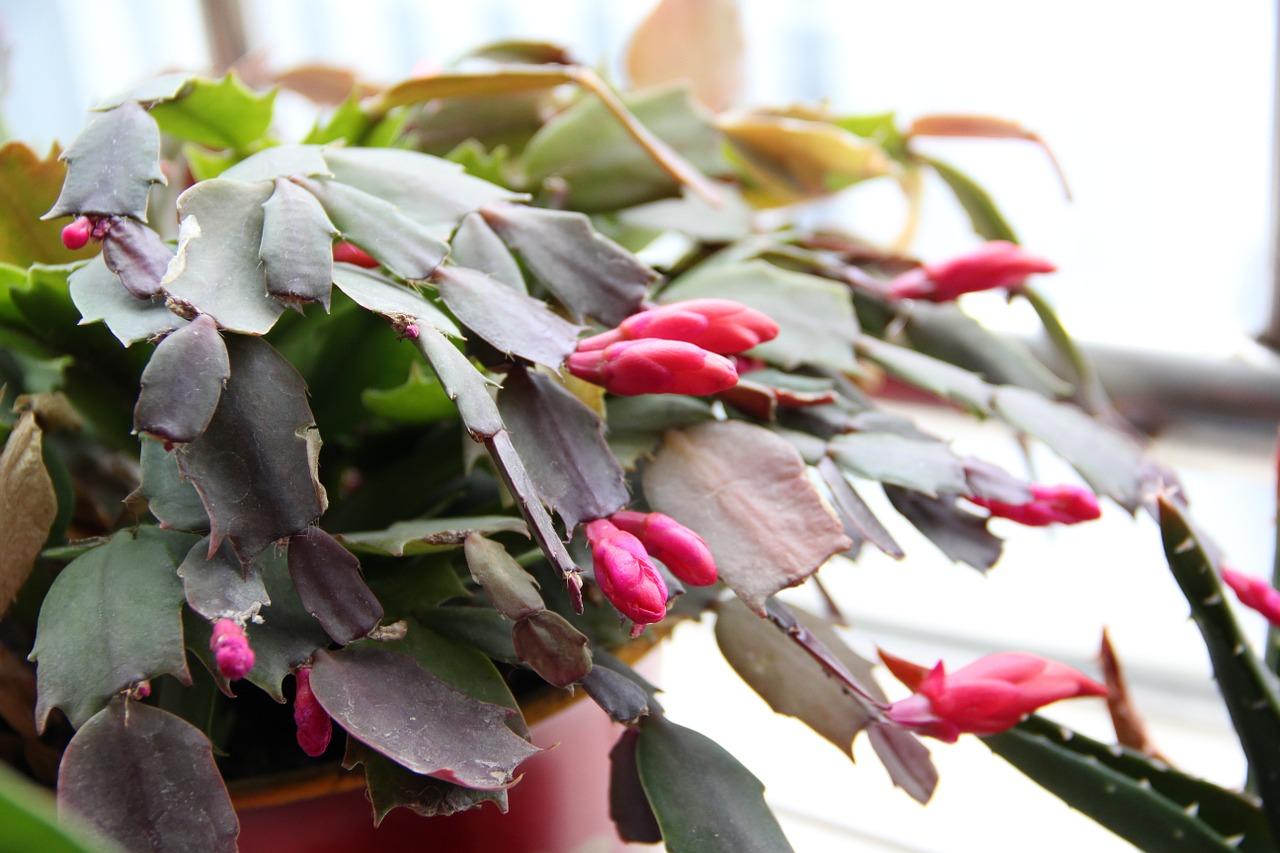
Choosing Your Spot, Soil, and Set-Up
1.Give your Christmas Cactus bright but indirect light. Keep the plant in a well-lit location (like near a window) away from direct sunlight – too much heat and light can stunt growth and burn the leaves. It should also be away from drafts, heat vents, fireplaces or other sources of hot air.[1]
Move an indoors plant outdoors in summer to a shady location. It is best to keep in a normal house temperature range, about 65 to 75°F (18 to 20°C). That being said, cooler night temperatures can be used to initiate blooming. We'll discuss getting it to bloom in the final section.
If it's in a north or east-facing window, you won't have to worry about light. But if it's in a south or west-facing window, diffuse the light with semi-transparent curtains or some other light-diffusing device.
2.Provide the plant a source of humidity if you live in a dry environment. Put a tray of water next to the plant so that the water evaporates and provides humidity. Alternatively, you can make a humidity tray by placing the pot on a waterproof saucer that is filled with gravel and halfway filled with water.
50 to 60% humidity is the ultimate goal.[2] If your environment is close to that, you should be fine.
3.Use a well-draining container and well-draining soil. For the container, some of the cheap nursery planters will work well, and orchid planters (the plastic basket kind) work well also. Pair this planter with a planter that will hold water and allow the basket to fit down into it. Then, place a few medium sized rocks into the bottom so that the basket container will be held about an inch above the bottom. [3]
Use a combination of 3 parts potting soil to one part sand for the potting medium. An alternative is one part potting soil, two parts peat moss or compost, and one part sharp sand or perlite.[4] Whichever way you go, pour about two inches of room temperature water into the outer container and set the basket container inside. After about twelve hours, pour out any remaining water. Repeat this as often as the plant needs water; it will vary based on your home's condition. Monitor its need with a moisture prod and adjust accordingly.
4.Add fertilizer to assist plant growth. Plants that are actively growing should be given a blooming houseplant-type fertilizer. This is best done for a plant that is 2-3 weeks old. Follow the label directions for how much and how often to feed.
Fertilizing is important to keep the plant in good condition; the joints are fragile and can break apart if the plant descends into poor health. Generally, it should be fertilized 2-4 times a year with a 20-20-20 feed, but stop feeding about a month before the buds appear (this usually means stopping by the end of October).

Watering Your Christmas Cactus
1.Water a Christmas Cactus with care. Caring for this plant can be a bit tricky as you need to take care not to overwater or underwater it:
A Christmas cactus is a tropical cactus, not a desert cactus. Unlike most desert cacti, this variety cannot tolerate completely dry soil. If the soil gets too dry, the flowers buds will drop, and the plant will wilt. Feel the soil with your fingers; if it feels dry, it's time to water.
Too much watering will cause spots from white rot to appear on the leaves, and the leaves will likely fall off. The soil should be evenly moist for best growth. The rule of thumb is less water is better than too much water.
When watering, thoroughly water the plant. Before attempting to water the plant again, check to see that the top inch of soil has dried thoroughly first. Mist leaves as well as watering the soil.
2.Change your watering schedule seasonally. Water the cactus based on your environment and the time of year. A good method is to water a cactus as follows:[5]
Dry climate, outdoors: Water every two to three days when warm and sunny
Humid, cool or indoors: Water every week
During the fall and winter months, the plants should be watered less frequently in order to promote blooming.
3.Stop watering around October. When October hits, your watering duties are over. You can carefully resume a light watering in November. If it's dry where you live, feel free to place the pot over a tray of moist pebbles. This is all to set up the bloom happening around Christmas.
The only other time you should cease watering is after the plant blooms. At this time, cease watering for about 6 weeks to allow the plant to rest. New growth will still appear – and that is when watering should be resumed.
4.Watch out for bud drop. One of the most frustrating things that can happen to Christmas cactus is after the flower buds have developed they drop off the plant. Bud drop can be caused by several different conditions. Usually it's because of over-watering, but it can also be due to a lack of humidity or insufficient light.
If this starts happening, water the plant less and add some fertilizer to the pot. Move it to an area away from a hot radiator or vent and try a new spot where it can get a bit more sunlight.

Getting a Timely Bloom
1.Encourage the flower blooming for the holiday season by lowering the temperature. The key to getting Christmas cactus to flower during the holiday season is proper light exposure, correct temperatures and limited watering. If you manipulate these things yourself, you can time a bloom just how you'd like.
Because this plant is thermo-photoperiodic, it will set buds when day length is about equal to night length and when the temperature drops to 50 to 60 degrees F for several weeks. If the temperature drops further, the plant will not bloom.
From September and October, the Christmas Cactus should be kept in a cool room where temperatures will remain around 50-55°F (10-12°C), give or take a few degrees. Don't expose the plant to freezing temperatures. Plants should be blooming for the holidays if cool treatments are started by early November.
2.Keep the plant in a dark room during the night. During the fall months, the Christmas Cactus should be placed in a spot where it receives indirect, bright light during the daylight hours but total darkness at night – it requires long, uninterrupted dark periods of about 12 hours or more.[6]
Begin the dark treatments in about mid-October to have plants in full bloom by the holidays. Place the plants in a dark area from about 12 or more hours each night for 6-8 weeks or until you see buds forming. A closet or unused bathroom are ideal places.
Be especially careful with watering at this time. Reduce the watering slightly. Do not soak the soil after a dry period; only moisten the top few inches, since buds, flowers and even leaves can fall off if the roots are suddenly saturated.
3.When you see flower buds forming, increase light and humidity. The "dark ages" are over when your plant starts budding. At this point, you should increase, humidity, light, water (not too much, of course), and the temperature. In other words, continue as you were a few months ago.
If the buds form too early, you can lower the temperature to stunt them. When you're ready, up the temperature and they should resume their progress.[7]

Caring for Your Cactus Post-Bloom
1.Prune the Christmas cactus about a month after blooming. This will encourage the plant to branch out, especially after a period of "rest" has been granted. It will not look very pretty after the blossoms have faded. Some people wait until March or so, when new growth begins, to prune the cactus.
As mentioned before, cease watering for 30 days post-bloom. When you see new growth forming, you can begin watering again.
2.Propagate a Christmas Cactus by cutting off short, Y-shaped sections of the stem. Each section must consist of two or three joined segments. Allow each section to dry for a few hours before pushing them into a 3-inch pot that contains the same potting soil as the parent plant. Plant halfway down the first segment and water sparingly to prevent rot from developing.[8]
Treat the cuttings as mature plants. In about four to six weeks, the cuttings should have rooted and will begin to show some new growth. They grow quickly, and should take in about two or three weeks. You can fertilize after the cutting has grown one new segment.
3.Repot every 2-3 years. Your plant should be fine for a couple of years unless the root system gets diseased or harmed. Apart from this, a new pot is needed when the roots have filled it or when the soil has been officially depleted of nutrients. Most people do this in the spring.
When replanting or repotting, use new, fresh soil. It's worth the few extra dollars since it will probably be sitting in that soil for a long time. Your plant is a living thing like you, so it deserves the best.
The best time for repotting is between February and April, about once every three years.[9] Just be sure not to give it a pot that's too big; the Christmas Cactus flowers best when it's pot-bound.

10
7
Miss Chen:溜溜溜
文章
Dummer. ゛☀
2017年07月02日

The growth habit of
Jerusalem artichoke is a relatively hardy and drought tolerant plant that can withstand low temperatures. When breeding, pay attention to adequate lighting. When choosing soil, it is not high, but acid soil, swamp and saline alkali soil are not suitable for planting.
The comprehensive utilization value of Jerusalem artichoke
Jerusalem artichoke value is relatively high, it is edible, stem and leaf can be used as feed, the tubers can be processed into vegetables or pickles, can also be used as inulin and alcohol, and Jerusalem artichoke or a valuable industrial raw materials.
Morphological characteristics
Jerusalem artichoke is a perennial herb, 1-3 m tall, with a mass of underground stems and fibrous roots. Stems erect, branched, white, shortly strigose or setose. Usually, the leaf petiole, but the upper part of Ye Husheng; the lower leaves ovate or ovate elliptic, with a long handle, 10-16 cm long, 3-6 cm wide, base broadly cuneate or rounded, sometimes slightly cordate, apex tapering acuminate, margin coarsely serrate, from base three above is below the white veined, stubby wool, puberulent, with short bristles veins, upper leaves oblong to broadly lanceolate, base attenuate, decurrent into short winged, apex acuminate, short tail.
The capitulum is large, few or many, was born in a single branch end, there are 1-2 linear lanceolate bracts, erect, 2-5 cm in diameter, involucral bracts multilayer, lanceolate, 14-17 mm long, 2-3 mm wide.


Jerusalem artichoke is a relatively hardy and drought tolerant plant that can withstand low temperatures. When breeding, pay attention to adequate lighting. When choosing soil, it is not high, but acid soil, swamp and saline alkali soil are not suitable for planting.
The comprehensive utilization value of Jerusalem artichoke
Jerusalem artichoke value is relatively high, it is edible, stem and leaf can be used as feed, the tubers can be processed into vegetables or pickles, can also be used as inulin and alcohol, and Jerusalem artichoke or a valuable industrial raw materials.
Morphological characteristics
Jerusalem artichoke is a perennial herb, 1-3 m tall, with a mass of underground stems and fibrous roots. Stems erect, branched, white, shortly strigose or setose. Usually, the leaf petiole, but the upper part of Ye Husheng; the lower leaves ovate or ovate elliptic, with a long handle, 10-16 cm long, 3-6 cm wide, base broadly cuneate or rounded, sometimes slightly cordate, apex tapering acuminate, margin coarsely serrate, from base three above is below the white veined, stubby wool, puberulent, with short bristles veins, upper leaves oblong to broadly lanceolate, base attenuate, decurrent into short winged, apex acuminate, short tail.
The capitulum is large, few or many, was born in a single branch end, there are 1-2 linear lanceolate bracts, erect, 2-5 cm in diameter, involucral bracts multilayer, lanceolate, 14-17 mm long, 2-3 mm wide.


1
1
文章
Dummer. ゛☀
2017年07月02日

Growth habit of Eurasian mustard
Eurasian mustard is a kind of plant adaptability is strong, when breeding blue incense mustard, usually need full sun environment, appropriate shading in summer time. The soil is generally wet and well drained.
Eurasian mustard breeding is generally self reproduction, generally second years after planting to flower.
The Eurasian mustard flower smells like lilacs.
The flowers and culture of the blue mustard
clustered on the branches, so called wild Phlox, but less than a petal petal phlox.
Morphological characteristics of the mustard blue
Is a perennial or biennial shorter growth period of plants. The vertical height of about 60, much branched, to 90 cm, usually less than 120 cm. 30 ~ 60 cm width. Leaf margin serrate, elliptic to, dark green. Flowers are white, pale purple or purple flower diameter 1.2 ~ 2.4 cm, 4 petals, racemes, and is very similar. Because the flowers and Phlox are similar, are clustered on a long handle, so it is often called the "wild Phlox", but the blue petals less than sweet mustard phlox tablets. Flowers have a clove like scent, especially in the evening, with a strong fragrance.
Per cluster of flowers than , flower shape and color consistency. The seed ratio of small, per kilogram of seed is about 540 thousand grains, and usually less than 400 thousand grains of .


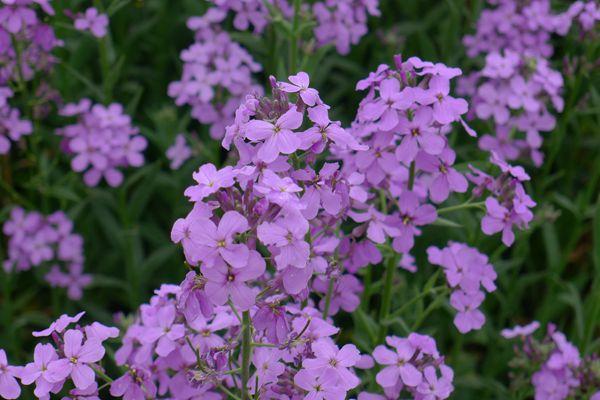
Eurasian mustard is a kind of plant adaptability is strong, when breeding blue incense mustard, usually need full sun environment, appropriate shading in summer time. The soil is generally wet and well drained.
Eurasian mustard breeding is generally self reproduction, generally second years after planting to flower.
The Eurasian mustard flower smells like lilacs.
The flowers and culture of the blue mustard
clustered on the branches, so called wild Phlox, but less than a petal petal phlox.
Morphological characteristics of the mustard blue
Is a perennial or biennial shorter growth period of plants. The vertical height of about 60, much branched, to 90 cm, usually less than 120 cm. 30 ~ 60 cm width. Leaf margin serrate, elliptic to, dark green. Flowers are white, pale purple or purple flower diameter 1.2 ~ 2.4 cm, 4 petals, racemes, and is very similar. Because the flowers and Phlox are similar, are clustered on a long handle, so it is often called the "wild Phlox", but the blue petals less than sweet mustard phlox tablets. Flowers have a clove like scent, especially in the evening, with a strong fragrance.
Per cluster of flowers than , flower shape and color consistency. The seed ratio of small, per kilogram of seed is about 540 thousand grains, and usually less than 400 thousand grains of .



0
0
文章
Dummer. ゛☀
2017年07月01日

Crowtoe nickname
Five grass, bird foot beans, Lotus .
The morphological characteristics of Crowtoe
The plant height of 15-50 cm, lateral branches; root, stems tufted, prostrate growth, stem smooth, stem length of about 70 cm; in stem apex at three leaves, leaf blade , two large and leaves are very close, so also known as the five umbrella shaped grass; about 4-8 in flower inflorescence, apex, color yellowish or yellow pods; in the top, crack spread, like the bird's foot, so a bird foot beans this nickname; seeds brown .
The growth habit
Love the warm and humid climate, the most suitable growth temperature is 18-25 DEG C; seedling not cold, plant cold tolerance slightly, but less than 5 DEG C and yellow leaf. on soil demand is not high, but in the fertile well drained soil grew well. Lotus as a long day plant, no shade, sufficient sunshine can promote flowering.
farming
Lotus on the strict requirements of the soil, in sandy loam, clay loam, barren, low wetland poor drainage, slightly acidic or slightly alkaline soil can be planted. Seeds small, thin seedlings, unearthed ability is poor, requires a fine preparation, to ensure all seedlings. In the year before the post harvest should be autumn , tillage, stubble weeding v. Dry autumn rake was soil moisture conservation, soil moisture in winter irrigation irrigation to suppress, bubble, and rake was suppressed moisture. The following year before seeding to crusher, shallow soil and ground leveling.
Apply fertilizer
after sowing, with longer life, consumption of large amount of fertilizer, with a deep autumn over enough base fertilizer, organic fertilizer per acre 1500 ~ 2500 kg, 25 kg to 50 standard , must be mixed with manure, sprinkle water to wet, the maturity of the accumulation of 20 ~ 30 days of fermentation. Combined with deep tillage, 5~10 kg of ammonium nitrate was applied before sowing to promote seedling growth.
Sow
Seed fields are sown with the first class seeds prescribed by the national or provincial forage quality standards. Lotus seed hard to high rate of hard seed treatment before sowing, treatment methods are: a mechanical scratch coat, with warm water soak 24 hours, dry sowing; concentrated sulfuric acid for 20 to 30 minutes, rinse with water, dry sowing, sowing amount due to the use of purpose, seed field drill, Mu 0.4 ~ 0.5 kg, 30 ~ 40 cm spacing. Collect grass drill, 0.5 ~ 0.6 kg per mu, 20 ~ 30 cm spacing, into 0.7 ~ 0.8 kg, and grass mixed sowing, accounted for 40 ~ 50%. Sow depth of 1~2 cm. Sowing time due to differences in the different climate regions, the cold regions should be early spring sowing, warm spring area can, can summer and autumn, autumn should not be later than late August, to make the seedling growth period of 1 months or more, to facilitate the winter. Reseeding natural grassland improvement in winter has winter sowing. The establishment of a permanent artificial grassland, can also can be mixed , broadcast, commonly used for mixed grasses are Kentucky bluegrass, chicken feet grass, perennial , high meadow etc.. Mixture proportion, accounted for 40 ~ 50%. In pure breeding, the roots or stems can be cut and cut to propagate. When the natural grassland is improved by seeding, it can be adjusted and controlled so as to make the seed fully mature and easy to propagate by seed.
Field management
The seedlings grow slowly, susceptible weeds, timely cultivation, hoe, forbidden grazing, trampling damaged seedlings. Grassland can not be used after grazing, too heavy use, or after irrigation, rainfall after grazing, without loss of vitality. Each time the pasture is used, it should be separated by half a month to regenerate it. After every grazing or cutting, the irrigation area should combine irrigation and topdressing, and the land should use the rainfall plus fertilizer. 10~15 kg of per mu, 4~5 kg of phosphate or ammonium nitrate. Cutting stubble 5~8 cm, grazing stubble 10~15 cm.
Common insect pest
The grassland caterpillar, , alfalfa seeds, bee grubs, alfalfa and wheat ,Yes.
Harvesting and utilization
The florescence is long, the seed maturity is not consistent, after mature, easy to crack the pod to fall the grain, in 70% when the fruit pod turns to the dark brown, then may cut to receive the kind, may conditionally follow the ripe to gather, carries on the stage by stage. Artificial grassland for optimum mowing flowers for the early flowering stage to fill, for grazing period began branching period to bud stage, or grass height up to 20 cm of moderate grazing, avoid heavy grazing or rainfall, irrigation after grazing. The root stubble fertilizer efficiency is very high, often using cereal and forage crop and economic crop rotation. Seed field and soil and water conservation cultivation is a good nectar, flowering season, will be shipped around the hive, promote pollination, increase seed yield, make full use of bee.



Five grass, bird foot beans, Lotus .
The morphological characteristics of Crowtoe
The plant height of 15-50 cm, lateral branches; root, stems tufted, prostrate growth, stem smooth, stem length of about 70 cm; in stem apex at three leaves, leaf blade , two large and leaves are very close, so also known as the five umbrella shaped grass; about 4-8 in flower inflorescence, apex, color yellowish or yellow pods; in the top, crack spread, like the bird's foot, so a bird foot beans this nickname; seeds brown .
The growth habit
Love the warm and humid climate, the most suitable growth temperature is 18-25 DEG C; seedling not cold, plant cold tolerance slightly, but less than 5 DEG C and yellow leaf. on soil demand is not high, but in the fertile well drained soil grew well. Lotus as a long day plant, no shade, sufficient sunshine can promote flowering.
farming
Lotus on the strict requirements of the soil, in sandy loam, clay loam, barren, low wetland poor drainage, slightly acidic or slightly alkaline soil can be planted. Seeds small, thin seedlings, unearthed ability is poor, requires a fine preparation, to ensure all seedlings. In the year before the post harvest should be autumn , tillage, stubble weeding v. Dry autumn rake was soil moisture conservation, soil moisture in winter irrigation irrigation to suppress, bubble, and rake was suppressed moisture. The following year before seeding to crusher, shallow soil and ground leveling.
Apply fertilizer
after sowing, with longer life, consumption of large amount of fertilizer, with a deep autumn over enough base fertilizer, organic fertilizer per acre 1500 ~ 2500 kg, 25 kg to 50 standard , must be mixed with manure, sprinkle water to wet, the maturity of the accumulation of 20 ~ 30 days of fermentation. Combined with deep tillage, 5~10 kg of ammonium nitrate was applied before sowing to promote seedling growth.
Sow
Seed fields are sown with the first class seeds prescribed by the national or provincial forage quality standards. Lotus seed hard to high rate of hard seed treatment before sowing, treatment methods are: a mechanical scratch coat, with warm water soak 24 hours, dry sowing; concentrated sulfuric acid for 20 to 30 minutes, rinse with water, dry sowing, sowing amount due to the use of purpose, seed field drill, Mu 0.4 ~ 0.5 kg, 30 ~ 40 cm spacing. Collect grass drill, 0.5 ~ 0.6 kg per mu, 20 ~ 30 cm spacing, into 0.7 ~ 0.8 kg, and grass mixed sowing, accounted for 40 ~ 50%. Sow depth of 1~2 cm. Sowing time due to differences in the different climate regions, the cold regions should be early spring sowing, warm spring area can, can summer and autumn, autumn should not be later than late August, to make the seedling growth period of 1 months or more, to facilitate the winter. Reseeding natural grassland improvement in winter has winter sowing. The establishment of a permanent artificial grassland, can also can be mixed , broadcast, commonly used for mixed grasses are Kentucky bluegrass, chicken feet grass, perennial , high meadow etc.. Mixture proportion, accounted for 40 ~ 50%. In pure breeding, the roots or stems can be cut and cut to propagate. When the natural grassland is improved by seeding, it can be adjusted and controlled so as to make the seed fully mature and easy to propagate by seed.
Field management
The seedlings grow slowly, susceptible weeds, timely cultivation, hoe, forbidden grazing, trampling damaged seedlings. Grassland can not be used after grazing, too heavy use, or after irrigation, rainfall after grazing, without loss of vitality. Each time the pasture is used, it should be separated by half a month to regenerate it. After every grazing or cutting, the irrigation area should combine irrigation and topdressing, and the land should use the rainfall plus fertilizer. 10~15 kg of per mu, 4~5 kg of phosphate or ammonium nitrate. Cutting stubble 5~8 cm, grazing stubble 10~15 cm.
Common insect pest
The grassland caterpillar, , alfalfa seeds, bee grubs, alfalfa and wheat ,Yes.
Harvesting and utilization
The florescence is long, the seed maturity is not consistent, after mature, easy to crack the pod to fall the grain, in 70% when the fruit pod turns to the dark brown, then may cut to receive the kind, may conditionally follow the ripe to gather, carries on the stage by stage. Artificial grassland for optimum mowing flowers for the early flowering stage to fill, for grazing period began branching period to bud stage, or grass height up to 20 cm of moderate grazing, avoid heavy grazing or rainfall, irrigation after grazing. The root stubble fertilizer efficiency is very high, often using cereal and forage crop and economic crop rotation. Seed field and soil and water conservation cultivation is a good nectar, flowering season, will be shipped around the hive, promote pollination, increase seed yield, make full use of bee.



0
0
文章
Dummer. ゛☀
2017年07月01日

Herba Dianthi nickname
The nickname is yemai, Dianthus stone flowers, flowers, ten kinds of landscape flower, mountain bamboo Dianthus, red flowers, nadeshiko.
The growth habit of Herba Dianthi
Herba Dianthi farming is simple plant breeding by pouring, planting and breeding, can also carry out ramet reproduction.
Herba Dianthi requirements of the soil is high, the general choice of well drained sandy soil is good. Water on the growth of Herba Dianthi is very important, need to pay attention to, not too dry or overwatered, ensure proper water can be. Fertilization, usually 3 times a year topdressing.
The value of Herba Dianthi
Herba Dianthi can do potted flowers for breeding, can also be raised in the flower, it has high medicinal value, can treat a variety of diseases. Will be made into Herba Dianthi pesticide, insecticide can.
Morphological character
Herbs perennial, 50-60 cm tall, sometimes taller. Stems tufted, erect, green, glabrous, Kobe Bunmie. Leaves linear lanceolate, 5-10 cm long, 3-5 mm wide, apex acute, midvein prominent, base forming sheaths, green, sometimes with pink green. Leaves opposite, more wrinkled, flattened, blade striped to lanceolate. Stems terete, with branches above, 30~60 cm long, surface pale green or yellow green, smooth, glabrous, nodes distinct, slightly inflated, hollow in section. Branches with flowers and fruits, calyx tube shaped, 2.7~3.7 cm long; bracts 4~6, broadly ovate, 1/4 long, calyx tube, petals brown, purple or brownish yellow, curly, apex deeply filiform. Capsule long tubular, as long as persistent calyx. Spend 1 or 2 lives under the top branch end, sometimes axillary; bracts obovate, 2-3, 6-10 mm long, about calyx 1/4, 4-5 mm wide, apex long acuminate; calyx cylindric, 2.5-3 cm long, 3-6 mm in diam., often dyed purple halo, calyx teeth lanceolate, 4-5 mm long; petals claw 4-5 cm long, 1.5-3 cm long, wrapped in a calyx tube, petals broadly obovate, margin of their cleft to middle or above middle, usually pale red or purplish, thin white, throat with silk hair like scales; stamens and style slightly exserted. The capsule is cylindrical, with persistent calyx length or slightly long, flat top 4 crack; seed ovoid, ca.



The nickname is yemai, Dianthus stone flowers, flowers, ten kinds of landscape flower, mountain bamboo Dianthus, red flowers, nadeshiko.
The growth habit of Herba Dianthi
Herba Dianthi farming is simple plant breeding by pouring, planting and breeding, can also carry out ramet reproduction.
Herba Dianthi requirements of the soil is high, the general choice of well drained sandy soil is good. Water on the growth of Herba Dianthi is very important, need to pay attention to, not too dry or overwatered, ensure proper water can be. Fertilization, usually 3 times a year topdressing.
The value of Herba Dianthi
Herba Dianthi can do potted flowers for breeding, can also be raised in the flower, it has high medicinal value, can treat a variety of diseases. Will be made into Herba Dianthi pesticide, insecticide can.
Morphological character
Herbs perennial, 50-60 cm tall, sometimes taller. Stems tufted, erect, green, glabrous, Kobe Bunmie. Leaves linear lanceolate, 5-10 cm long, 3-5 mm wide, apex acute, midvein prominent, base forming sheaths, green, sometimes with pink green. Leaves opposite, more wrinkled, flattened, blade striped to lanceolate. Stems terete, with branches above, 30~60 cm long, surface pale green or yellow green, smooth, glabrous, nodes distinct, slightly inflated, hollow in section. Branches with flowers and fruits, calyx tube shaped, 2.7~3.7 cm long; bracts 4~6, broadly ovate, 1/4 long, calyx tube, petals brown, purple or brownish yellow, curly, apex deeply filiform. Capsule long tubular, as long as persistent calyx. Spend 1 or 2 lives under the top branch end, sometimes axillary; bracts obovate, 2-3, 6-10 mm long, about calyx 1/4, 4-5 mm wide, apex long acuminate; calyx cylindric, 2.5-3 cm long, 3-6 mm in diam., often dyed purple halo, calyx teeth lanceolate, 4-5 mm long; petals claw 4-5 cm long, 1.5-3 cm long, wrapped in a calyx tube, petals broadly obovate, margin of their cleft to middle or above middle, usually pale red or purplish, thin white, throat with silk hair like scales; stamens and style slightly exserted. The capsule is cylindrical, with persistent calyx length or slightly long, flat top 4 crack; seed ovoid, ca.



0
0
求助
khaki83
2017年07月01日

I've just repotted my avocado plant, do I now need to cover the pip with soil? thanks :)
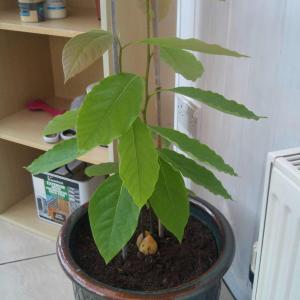

2
0
khaki83:@meriunkat I do too :) my first Avocado tree!
khaki83:@sunnyzou thank you :)
sunnyzou:I saw someone covered the pip.
meriunkat:I love avocados 😁
文章
Dummer. ゛☀
2017年06月30日

Nickname upon food
The dish is also called mature, and secondly, beans, rouge, the purple leaf angle soft ginger, vine vegetable, vegetables, sunflower and other aliases Zhong rouge.
The growth habit of Chan food
The dish is comparison of plant tolerance to high temperature and high humidity, it is love loose fertile sandy soil. The requirement of illumination is not high, and the suitable temperature for growth is between 25 and 30 degrees, and the soil should be kept moist.
The food is generally sowing reproduction.
Upon the role of food
The dish has a certain role in the garden, the plants and flowers are lovely, can be used as a decorative window, etc..
However, its biggest use is to eat, often used as vegetables, the taste is very good.
When eating is picking it near the stem part of the stem and leaf shape, a bit like broccoli, green green. Leaves, leaves alternate, heart shaped, 8-15 cm long, 9-16 cm wide, 0.2 cm thick, fleshy, fleshy, smooth, glabrous, with a short handle, can grow massive axillary bulbils, 2-4 cm long, 1-3 cm wide.
The young leaves and shoots soft and smooth, suitable for the boiling water, it is rich in vitamin C, calcium and carotene, can heat, cooling blood, slippery bowel, detoxification, enjoyed "hundred dishes king" reputation. The Song Dynasty Su Dongpo praise it "seems to be the enemy Chun soup". "Guangdong language" that it "leaves and edible, slightly sour in taste, are advised to fish soup". But people think it is more Chan (mucus), "said Chan food derogatory". Guangdong folk in cooking practice, find a method to make dishes Chan Chan Chan, the vegetable broth is made out of soup, it cool sweet, soft and smooth, with heat dampness, facilitate the bowels of the power, for the summer when the delicious family soup.



The dish is also called mature, and secondly, beans, rouge, the purple leaf angle soft ginger, vine vegetable, vegetables, sunflower and other aliases Zhong rouge.
The growth habit of Chan food
The dish is comparison of plant tolerance to high temperature and high humidity, it is love loose fertile sandy soil. The requirement of illumination is not high, and the suitable temperature for growth is between 25 and 30 degrees, and the soil should be kept moist.
The food is generally sowing reproduction.
Upon the role of food
The dish has a certain role in the garden, the plants and flowers are lovely, can be used as a decorative window, etc..
However, its biggest use is to eat, often used as vegetables, the taste is very good.
When eating is picking it near the stem part of the stem and leaf shape, a bit like broccoli, green green. Leaves, leaves alternate, heart shaped, 8-15 cm long, 9-16 cm wide, 0.2 cm thick, fleshy, fleshy, smooth, glabrous, with a short handle, can grow massive axillary bulbils, 2-4 cm long, 1-3 cm wide.
The young leaves and shoots soft and smooth, suitable for the boiling water, it is rich in vitamin C, calcium and carotene, can heat, cooling blood, slippery bowel, detoxification, enjoyed "hundred dishes king" reputation. The Song Dynasty Su Dongpo praise it "seems to be the enemy Chun soup". "Guangdong language" that it "leaves and edible, slightly sour in taste, are advised to fish soup". But people think it is more Chan (mucus), "said Chan food derogatory". Guangdong folk in cooking practice, find a method to make dishes Chan Chan Chan, the vegetable broth is made out of soup, it cool sweet, soft and smooth, with heat dampness, facilitate the bowels of the power, for the summer when the delicious family soup.



0
0
文章
Dummer. ゛☀
2017年06月30日

The growth habit of Huang Zhonghua
Huang Zhonghua, general is more like a plant light fear of floods, it love light, generally requires full sun or partial sunshine, choose when to choose soil well drained and rich in organic matter, it is best to add a little fertilizer in soil, good for flowering. Water is generally sufficient, because of the drought is disadvantageous to yellow sikkmensis terms.
The ornamental function of Huang Zhonghua
When Huang Zhonghua blossoms, it is always golden, golden and yellow. It is very bright and bright. It can be used for planting or planting trees. It can also be potted and preserved, and it can make a good decorative effect.
Morphological character
Perennial herb. Stem base stout, with persistent scales on top, scales ovate, ca. 3 mm, ca. 1 mm wide. The number of stems and, ascending, 7-12 cm long, unbranched or short branched, densely gray white villous development. Ye Husheng, the only spend 4 or 5 leaves were gathered from verticillate shape, lower stem to increase gradually, more dense, subsessile; leaf blade elliptic or ovate, 5-14 mm long, 3-8 mm wide, two sharp, edges reflexed, entire, two students to carry out gray white pilose or glabrous. Flowers solitary in the top of the stem, pedicels 1-2 cm long, glabrous or sparsely pubescent; calyx tube shaped, round bottom, fruit enlargement, tube length and width nearly equal, 8-10 mm, glabrous, lobes triangular, both the length and width of about 3 mm, in sparsely pilose; corolla yellow or pale yellow, 2.5-2.7 cm long. Outside glabrous, inside throat densely white pilose, lobes obovate oblong or obovate elliptic, 1.4-1.6 cm long, 5-7 mm wide, apex usually few rusty pilose; calyx tube and ovary at about equal length, style beyond the corolla. Florescence 7-8 months. [1]
Leaves of this species elliptic or ovoid, 5-14 mm long, 3-8 mm wide, both ends acute, entire; corolla yellow or pale yellow, lobes longer than tube, distinct from similar species. Type specimens were collected from Yunnan (Lijiang). This species contains two variants.



Huang Zhonghua, general is more like a plant light fear of floods, it love light, generally requires full sun or partial sunshine, choose when to choose soil well drained and rich in organic matter, it is best to add a little fertilizer in soil, good for flowering. Water is generally sufficient, because of the drought is disadvantageous to yellow sikkmensis terms.
The ornamental function of Huang Zhonghua
When Huang Zhonghua blossoms, it is always golden, golden and yellow. It is very bright and bright. It can be used for planting or planting trees. It can also be potted and preserved, and it can make a good decorative effect.
Morphological character
Perennial herb. Stem base stout, with persistent scales on top, scales ovate, ca. 3 mm, ca. 1 mm wide. The number of stems and, ascending, 7-12 cm long, unbranched or short branched, densely gray white villous development. Ye Husheng, the only spend 4 or 5 leaves were gathered from verticillate shape, lower stem to increase gradually, more dense, subsessile; leaf blade elliptic or ovate, 5-14 mm long, 3-8 mm wide, two sharp, edges reflexed, entire, two students to carry out gray white pilose or glabrous. Flowers solitary in the top of the stem, pedicels 1-2 cm long, glabrous or sparsely pubescent; calyx tube shaped, round bottom, fruit enlargement, tube length and width nearly equal, 8-10 mm, glabrous, lobes triangular, both the length and width of about 3 mm, in sparsely pilose; corolla yellow or pale yellow, 2.5-2.7 cm long. Outside glabrous, inside throat densely white pilose, lobes obovate oblong or obovate elliptic, 1.4-1.6 cm long, 5-7 mm wide, apex usually few rusty pilose; calyx tube and ovary at about equal length, style beyond the corolla. Florescence 7-8 months. [1]
Leaves of this species elliptic or ovoid, 5-14 mm long, 3-8 mm wide, both ends acute, entire; corolla yellow or pale yellow, lobes longer than tube, distinct from similar species. Type specimens were collected from Yunnan (Lijiang). This species contains two variants.



0
0
文章
Dummer. ゛☀
2017年06月30日

Brazil iris
Brazil irises are also called horse, butterfly, iris, jade and butterfly.
The growth habit of iris Brazil
Brazil iris is a relatively easy to plant and has a strong adaptability to the environment. General in the breeding time, Brazil iris on the demand of the light is not high, but in order to make its growth is good, still need to keep the sun or semi shade.
Watering is usually to keep the soil moist, but in the summer, pay attention to the lack of water.
Morphological editor
Brazil iris plant height of about 40 ~ 50 cm, leaf extract Congji of roots, fan-shaped arrangement. Leaves broadly 2 cm, leathery, dark green; flowering to spring to summer
Neomarica gracilis
Neomarica gracilis
Season, but in the flattened leaflike stems, ribs obvious from the flower stalk at sheathlike bracts inside out, flowers have 6 petals, white bracts 3 petals valgus, basally with reddish brown patches, the other 3 petals erect involute, purple blue and white lines. Flowers are usually open to 3 in the afternoon to morning, 4 a.m. involution withered, but the flowers bloom after intrathecal, grow seedlings, seedlings growing finally fell to the soil surface, the root of seedling, seedling and flowering ability have the following year. The mode of reproduction of Brazil iris is very strange, like Chlorophytum after flowering, flowers will grow seedlings from the sheath.



Brazil irises are also called horse, butterfly, iris, jade and butterfly.
The growth habit of iris Brazil
Brazil iris is a relatively easy to plant and has a strong adaptability to the environment. General in the breeding time, Brazil iris on the demand of the light is not high, but in order to make its growth is good, still need to keep the sun or semi shade.
Watering is usually to keep the soil moist, but in the summer, pay attention to the lack of water.
Morphological editor
Brazil iris plant height of about 40 ~ 50 cm, leaf extract Congji of roots, fan-shaped arrangement. Leaves broadly 2 cm, leathery, dark green; flowering to spring to summer
Neomarica gracilis
Neomarica gracilis
Season, but in the flattened leaflike stems, ribs obvious from the flower stalk at sheathlike bracts inside out, flowers have 6 petals, white bracts 3 petals valgus, basally with reddish brown patches, the other 3 petals erect involute, purple blue and white lines. Flowers are usually open to 3 in the afternoon to morning, 4 a.m. involution withered, but the flowers bloom after intrathecal, grow seedlings, seedlings growing finally fell to the soil surface, the root of seedling, seedling and flowering ability have the following year. The mode of reproduction of Brazil iris is very strange, like Chlorophytum after flowering, flowers will grow seedlings from the sheath.



0
0



